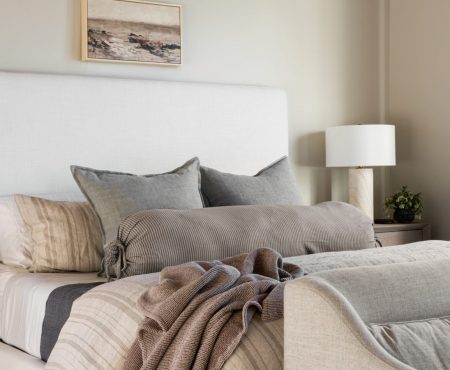When it comes to achieving a comfortable and restful night’s sleep, the choice of bedding fabric plays a pivotal role. Different seasons and varying temperatures call for bedding materials that offer the right balance of warmth, breathability, and comfort. From the crisp coolness of linen to the cozy warmth of flannel, exploring different bedding fabrics allows you to tailor your sleep environment to suit the changing seasons. In this article, we delve into the world of bedding fabrics, examining their unique characteristics, benefits, and suitability for different times of the year.
Linen: A Breathable and Airy Option for Summer
Linen is a natural and lightweight fabric that has gained popularity for its breathability and airy texture. Derived from the flax plant, linen is prized for its ability to wick away moisture, keeping you cool and comfortable during hot summer nights. The loosely woven fibers create a natural airflow that helps regulate body temperature, making linen an excellent choice for those seeking a refreshing sleep experience. Its relaxed and slightly wrinkled appearance adds a touch of effortless elegance to your bedroom decor.
Cotton: Versatile Comfort for All Seasons
Cotton is perhaps the most versatile and widely used bedding fabric, offering comfort and softness year-round. Available in various thread counts, cotton bedding provides options for different levels of softness and durability. In warmer months, lightweight cotton sheets promote breathability and moisture-wicking, while higher thread count cotton can offer a cozy embrace during cooler seasons. The wide range of colors, patterns, and styles available in cotton bedding makes it a staple for creating a tailored and inviting sleep environment.
Microfiber: Modern Comfort and Easy Care
Microfiber bedding has gained popularity for its modern appeal, durability, and low-maintenance care. This synthetic fabric is woven with finely textured fibers that create a soft and silky feel. Microfiber bedding is known for its hypoallergenic properties, making it a suitable choice for individuals with allergies. Its wrinkle-resistant nature and ease of care make microfiber an attractive option for those seeking both comfort and convenience in their bedding.
Flannel: Cozy Warmth for Chilly Nights
As the temperature drops and chilly nights set in, flannel bedding emerges as a cozy and inviting option. Flannel is a brushed cotton fabric that retains warmth exceptionally well, making it ideal for the colder months. The soft, napped surface of flannel adds an extra layer of insulation, creating a cocoon-like feel that is perfect for snuggling up on winter evenings. Flannel bedding is often associated with comfort and nostalgia, evoking feelings of warmth and relaxation.
Silk: A Touch of Luxury and Sensuality
Silk bedding is synonymous with luxury and indulgence, offering a sumptuous and sensuous sleep experience. This natural fiber is known for its smooth texture and temperature-regulating properties. Silk bedding can keep you cool in the summer and warm in the winter, making it a versatile choice for year-round comfort. Its lustrous appearance adds an element of opulence to your bedroom, creating a sense of refinement and elegance.
Wool: Natural Insulation and Breathability
Wool bedding is an excellent option for those seeking natural insulation and breathability. Wool fibers have the remarkable ability to trap air, providing warmth without overheating. Wool bedding is also known for its moisture-wicking properties, helping to regulate humidity and create a dry sleep environment. This makes wool bedding a suitable choice for individuals who experience temperature fluctuations throughout the night.
Bamboo: Sustainable and Silky Soft
Bamboo bedding is a sustainable and eco-friendly choice that has gained popularity for its silky softness and moisture-wicking capabilities. Bamboo fibers are naturally breathable and hypoallergenic, making them suitable for sensitive skin. Bamboo bedding is also known for its antimicrobial properties, helping to keep your sleep environment fresh and clean. The sustainable nature of bamboo makes it an environmentally conscious choice for those who prioritize eco-friendly products.
Blending Fabrics for the Perfect Sleep Experience
In some cases, combining different bedding fabrics can provide the best of both worlds. For example, a blend of cotton and silk can offer the temperature-regulating benefits of silk with the softness and durability of cotton. Similarly, a blend of cotton and flannel can create a cozy yet breathable sleep environment that adapts to changing temperatures. Experimenting with fabric blends allows you to tailor your bedding to your specific comfort preferences.
Choosing Seasonal Bedding: A Practical Approach
To create the ultimate sleep sanctuary, consider adopting a seasonal approach to bedding. As temperatures change, switch out your bedding to align with the current season. Opt for lightweight and breathable fabrics like linen or cotton for the summer, and transition to warmer options like flannel or wool for the winter. This practical approach ensures that your bedding is not only comfortable but also optimized for the prevailing weather conditions.
In conclusion, exploring different bedding fabrics opens up a world of possibilities for achieving optimal comfort and restful sleep. Whether you prefer the breathable coolness of linen, the versatile comfort of cotton, the cozy warmth of flannel, or the luxurious softness of silk, there is a bedding fabric that suits your preferences and sleep needs. By carefully selecting bedding materials that align with the changing seasons, you can create a sleep environment that is both inviting and conducive to a peaceful night’s rest.












